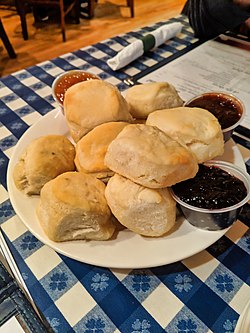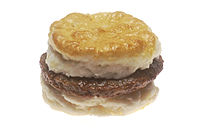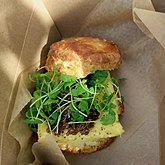Biscuit (bread)
 Biscuits with jam | |
| Type | Quick bread |
|---|---|
| Course | Breakfast, lunch, dinner |
| Place of origin | United States |
| Main ingredients | Flour, baking powder, solid fat such as shortening, milk |
| 200[1] kcal | |
In the United States, a biscuit is a variety of baked bread with a firm, dry exterior and a soft, crumbly interior. In Canada it sometimes also refers to this or a traditional European biscuit. It is made with baking powder as a leavening agent rather than yeast, and at times is called a baking powder biscuit to differentiate it from other types.[2] Like other forms of bread, a biscuit is often served with butter or other condiments, flavored with other ingredients, or combined with other types of food to make sandwiches or other dishes.
Biscuits, soda breads, cornbread, and similar breads are all considered quick breads, meaning that they do not need time for the dough to rise before baking.[3][4]
Biscuits developed from hardtack, which was first made from only flour and water, with later first lard and then baking powder being added.[5] The long development over time and place explains why the word biscuit can, depending upon the context and the speaker's English dialect, refer to very different baked goods.
History
[edit]Earlier history
[edit]American English and British English use the same word to refer to two distinctly different modern foods. Early hard biscuits (United States: cookies) were derived from a simple, storable version of bread.[6] The word "biscuit" itself originates from the medieval Latin word biscoctus, meaning "twice-cooked".
The modern Italian baked goods known as biscotti (also meaning "twice-cooked" in Italian) most closely resemble the Medieval Latin item and cooking technique.

The differences in the usage of biscuit in the English speaking world are remarked on by Elizabeth David in English Bread and Yeast Cookery. She writes,
It is interesting that these soft biscuits are common to Guernsey, and that the term biscuit as applied to a soft product was retained in these places, and in America, whereas in England it has completely died out.[7]
Early British settlers in the United States brought with them a simple, easy style of cooking, most often based on ground wheat and warmed with gravy.[6] Most were not wealthy men and women, and so it was a source of cheap nutrition. A very similar practice was also popular once with the Royal Navy as hard, flour-based biscuits would keep for long journeys at sea but would also become so difficult to chew that they had to be softened up. These were first introduced in 1588 to the rations of ships and found their way into the New World by the 1700s at the latest.
The biscuit emerged as a distinct food type in the early 19th century, before the American Civil War. Cooks created a cheaply produced addition for their meals that required no yeast, which was expensive and difficult to store. With no leavening agents except the bitter-tasting pearlash available, beaten biscuits were laboriously beaten and folded to incorporate air into the dough which expanded when heated in the oven causing the biscuit to rise. In eating, the advantage of the biscuit over a slice of bread was that it was harder, and hence kept its shape when wiping up gravy in the popular combination biscuits and gravy.
In 1875, Alexander P. Ashbourne patented the first biscuit cutter in the United States, useful for making cookies, cakes, or baking powder biscuits.[8][9] It consisted of a board to roll the biscuits out on, which was hinged to a metal plate with various biscuit cutter shapes mounted to it.
Later history
[edit]
Southern chefs may have had an advantage in creating biscuits. Northern American all-purpose flours, mainly grown in Ohio, Indiana and Illinois, are made from the hard spring wheats that grow in the North's cold-winter climate. Southern American bleached all-purpose flours, originally grown in the Carolinas, Georgia and Tennessee before national food distribution networks, are made from the soft winter wheat that grows in the warm Southern summer. This summer growth results in wheat that has less protein, which is more suited to the creation of quick breads, as well as cookies, cakes and muffins.[10][11]
Pre-shaped ready-to-bake biscuits can be purchased in supermarkets, in the form of small refrigerated cylindrical segments of dough encased in a cardboard can. These refrigerator biscuits were patented by Ballard and Ballard in 1931.[6]
Preparing
[edit]Originally, biscuits were little more than wheat flour and water, baked to form hardtack, which was carried by travelers because it stored for long periods of time. By the early 1800s, commercial baking powder was developed and the biscuit took a form that resembles the modern biscuit.
A typical modern recipe will include baking powder or baking soda, flour, salt, shortening or butter, and milk or buttermilk. The percentages of these ingredients vary as historically the recipe would pass orally from family to family and generation to generation. Biscuits are almost always a savory food item. Sugar is rare or included in only small quantities, and was not part of the traditional recipe. Self-rising flour can be used, which combines leavening agents with flour to simplify mixing.
Biscuits can be prepared for baking in several ways. The dough can be rolled out flat and cut into rounds, which expand when baked into flaky-layered cylinders (rolled biscuits). If extra liquid is added, the dough's texture changes to resemble stiff pancake batter so that small spoonfuls can be dropped upon the baking sheet to produce drop biscuits, which are more amorphous in texture and shape.[12]
Although most biscuits are made without yeast, a type of biscuit called an angel biscuit contains yeast as well, as do those made with a sourdough starter.[13]
Serving
[edit]Biscuits may be eaten for breakfast. They are meant to be served warm with a choice of spread of butter, honey, cane syrup, or some fruit-based jam. A savory breakfast is also possible, with biscuits cut in half becoming the Southern version of the breakfast sandwich, in which any combination of Country ham, tomato, scrambled eggs, bacon, or sausage is put in the biscuits' halves as a filling. They are sometimes served with a biscuit warmer, with the aim of keeping the biscuit warm throughout the duration of the meal.[citation needed]
For dinner, they are a popular accompaniment to fried chicken, nearly all types of Southern barbecue, and several Lowcountry dishes.[14] They also often figure in to the Southern version of Thanksgiving dinner as well.[15]
-
Open biscuit with honey being drizzled in it
-
Biscuit with fried chicken thigh and sausage gravy at Biscuit Love in Nashville, Tennessee
-
North Carolina Style Southern Fried Chicken Biscuit prepared by The Ji Spot in Taipei, Taiwan.
Variations
[edit]
Cat head biscuits (or cathead biscuits) are named because of the larger size of the biscuit (about the size of a cat's head) and somewhat misshapen form. These are normally prepared rolled flat, without layers. [16]
Biscuits may be flavored with other ingredients. For example, the baker may add grated cheddar or American cheese to the basic recipe to produce cheese biscuits.[17] Home cooks may use mass-produced, ultra-processed refrigerator biscuits for a quicker alternative to rolled or drop biscuits.
A sweet biscuit layered or topped with fruit (typically strawberries) and whipped cream is one type of shortcake.
See also
[edit]- Scone — a British leavened bread-like baked good that is similar
- Bizcocho — various different baked food items across the Latin world
- Biskotso — a type of baked garlic bread from the Philippines
References
[edit]- ^ "Biscuits, plain or buttermilk, prepared from recipe". FoodData Central, USDA, Agricultural Research Service. 1 April 2019. FDC ID: 172670, NDB Number: 18016. Archived from the original on 2019-04-03. Retrieved 2023-06-25.
- ^ Gisslen, Wayne; Griffin, Mary Ellen; Bleu, Le Cordon (2006). Professional Cooking for Canadian Chefs. John Wiley & Sons. pp. 931–933. ISBN 978-0-471-66377-5. Retrieved 3 November 2022.
- ^ Irma S. Rombauer; Marion Rombauer Becker; Ethan Becker (2006). The Joy of Cooking. New York: Scribner. p. 627. ISBN 978-0-7432-4626-2.
- ^ Ojakangas, Beatrice A. (2003). Quick Breads. Sally Sturman (ills.). University of Minnesota Press. p. 1. ISBN 978-0-8166-4228-1. Archived from the original on 2024-04-02. Retrieved 2016-10-21.
- ^ Dupree, Nathalie; Graubart, Cynthia (2011). Southern Biscuits. Gibbs Smith. p. 12. ISBN 9781423621775. Retrieved 2020-11-24.
- ^ a b c Olver, Lynne (June 24, 2012). "history notes—cookies, crackers & biscuits". The Food Timeline. Archived from the original on August 4, 2012. Retrieved January 6, 2021.
- ^ Elizabeth David (1977). "Yeast Buns and Small Tea Cakes" ("Soft Biscuits" section). English Bread and Yeast Cookery. Penguin Books Ltd., London ISBN 0-7139-1026-7
- ^ "Science and Technology: African Inventors in the Americas". Archived from the original on 2024-04-02. Retrieved 2021-04-30.
- ^ US 170460, Ashbourne, Alexander P., "Improvement in biscuit-cutters", published 1875-11-30, issued 1875-11-30
- ^ Dewan, Shaila (2008-06-18). "Biscuit Bakers' Treasured Mill Moves North". The New York Times. Archived from the original on 2011-11-08. Retrieved 2010-01-15.
- ^ "How to make the best Buttermilk Biscuits". pinchmysalt.com. 18 September 2007. Archived from the original on 2010-01-14. Retrieved 2010-01-15.
- ^ Dupree, Nathalie; Graubart, Cynthia (2011). Southern Biscuits. Gibbs Smith. pp. 12–16. ISBN 978-1-4236-2176-8.
- ^ Dupree, Nathalie; Graubart, Cynthia (2011). Southern Biscuits. Gibbs Smith. p. 94. ISBN 978-1-4236-2176-8.
- ^ "The 11 Best Buttermilk Biscuits in Charleston". May 2, 2019. Archived from the original on March 8, 2021. Retrieved October 5, 2019.
- ^ "15 Dishes Every Southern Thanksgiving Dinner Should Have". The Spruce Eats. Archived from the original on 2019-09-23. Retrieved 2019-10-05.
- ^ Cara Rose (April 4, 2019). "The Appalachian Cat Head Biscuit". Pocahontas Times. Retrieved May 5, 2024.
- ^ Better Home's and Garden Cookbook
External links
[edit] Media related to Biscuits (bread) at Wikimedia Commons
Media related to Biscuits (bread) at Wikimedia Commons






